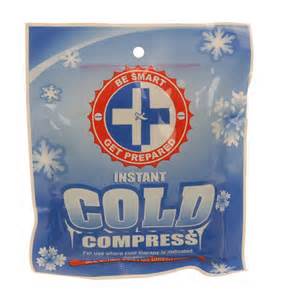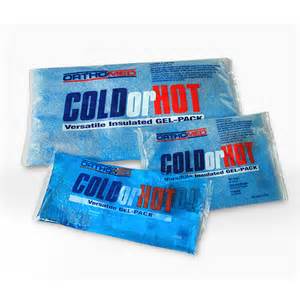Ice Therapy Is Part Of The R.I.C.E Therapy
Ice therapy has proven to be very useful in the treatment of injuries, especially sports related injuries, helping to reduce pain and inflammation. There exist a considerable amount of confusion of when to apply ice as a treatment and when to apply heat, which I intend to eliminate.
The very first thing which must be determined, which dictates what type of medical treatment is best, is the type of injury incurred. There are basically 2 types of injuries we’ll discuss, immediate professional medical treatment should be sought in injuries more serious than these two.
Acute and Chronic are the two types and degree of injuries we’ll concern ourselves over. The easiest way to remember which injury is which, is to memorize one definition, therefore the other type of injury is the other definition. ( I believe in conserving my brain power )
By definition an Acute injury is an injury which occurs suddenly and quickly over a short period of time, or over a couple of hours, which is traumatic and is usually the result of a strain, fall, collision or sprain. The pain associated with this type of injury is usually severe and quick to result.

Ready Made Ice Packs - Ice Therapy
In addition to pain, symptoms of acute injuries are swelling, tenderness, redness, and inflammation (warm to the touch) and nearly All acute injuries result in some degree of swelling.
By definition a Chronic injury subtly occurs over a period of time, with the symptoms possibly coming and going. This type of injury is usually a result of overuse or performing a repetitive action incorrectly. It can also result from not properly tending to an acute injury, which then becomes or creates a chronic injury.
Ice Treatment:
For all practical purposes, there’s always an exception to every rule, acute injuries involve swelling and pain in the injury body part, which involves internal bleeding inside the muscle area, as well as possible ligament, tendon or other injury.
Ice is a vaso-constrictor, in layman’s terms, reduces or restricts the size of the blood vessels, which reduces the amount of bleeding and reduces pain due to the numbing affect of the cold on the skin.
There are a few important points to remember when using an ice treatment.
1. Never apply ice directly to the skin of the injured area. Wrap the ice in a towel or rag before coming in contact with bare skin. If possible use an emergency ice pack designed for this purpose.
2. Do not leave the ice on the injured area for more than 10 minutes at a time, maximum 20 minutes. Remove the ice and allow the skin to regain normal body temperature before reapplying the ice.
3. The injured area can receive ice treatments as much as 4 or 5 times a day, but any more is probably counter-productive.
4. Because an acute injury is inflamed and warm due to injury, you’d never want to use heat treatment, which would only increase temperature and enhance the degree of injury.

Ice Therapy - Ready Made Hot Or Cold Packs
It might be noted here, ice treatments can also be used to treat a chronic injury, such as an athlete suffering from stiff or sore knees after running, the ice will reduce the inflammation.
Heat Therapy:
Heat therapy is historically used in the treatment of chronic injury where there doesn’t exist any current swelling or inflammation. Sore, stiff or aching muscles are better treated by applying Moist Heat to the area versus ice.
Heat therapy, because it raises the body’s heat, is often used prior to exercise in order to stretch and warm up sore and tight muscles and will help reduce muscle spasms which are normal in taunt muscles. Remember, do not use heat after exercising, use ice if therapy is required.
When applying heat therapy always use layers of cloth or other protective material, in order to prevent the skin from becoming burnt, and apply no longer than 20 minutes at any one time.
At the risk of being redundant, I feel it’s extremely important for any coach to be familiar with the RICE method of injury treatment, as the first 24 - 48 hours after the injury are the most important time of treatment.
Not to be alarming, but for instance, when there is soft tissue damage, say in a sprained ankle, blood vessels are ruptured and will bleed into the affected area. The increase in blood volume can cause cell destruction through what is known as Hypoxic Injury, thus it’s important to control any internal bleeding.

Ice Therapy - Examples Of Heat Pack Usage
What is RICE? In short, it’s acronyms for the gold standard in treating acute sports injuries.
R ---- Rest
I ---- Ice
C ---- Compression
E ---- Elevation
Each one of these precautions and/or medical treatment plays a significant part in reducing the severity of the injury and speeds the healing process.
Rest:
Rest does not mean a good night’s sleep after the injury occurs. Depending on the degree of the injury and severity of pain, many athletes will simply " Play Through the Pain” which can have disastrous long term results.
Based on a person’s pain threshold, everyone tolerates a different amount of pain, the player may increase the severity and recuperation time. In any event, the player should rest the injured body part as soon as possible as the first 24-48 hours are the most important.
Ice:
The immediate benefits of the use of ice, known as cryotherapy, in the treatment of an acute injury is well documented and medically proven. It is also a cheap, effective and quick medical treatment versus a trip to the hospital emergency room.
The benefits of ice therapy:
1. Reduces Muscle Spasms …
2. Reduces Pain …
3. Reduces cell death through slowing down bleeding and metabolism …
4. Reduces Swelling in the area.

Ice Therapy - The Old Reliable Ace Bandage
Compression:
The use of compression is rarely used or thought of in the amateur ranks, but professional sports, especially football, relies heavy on the treatment in order to get players back into the game a.s.a.p. despite the injury.
Using compression reduces the width of the blood vessels, which reduces bleeding and the inflammatory process, also reducing edema in the area and joints. This edema is what determines the amount of functional ability (use) of the limb.
The easiest method of applying compression is the utilization of compression bandages, which resemble a hollow, elastic tube. It’s easy to put on and provides sufficient pressure to stop excessive bleeding in the injured area.
In lieu of a compression bandage, a regular ace bandage can be wrapped around the injured area. Begin the wrapping below the injury and work up, overlapping each layer of bandage as you go. ----Ice Therapy
It’s important not to over tighten the bandage.
Should the area become dis-colored, cold or loses feeling, the bandage is too tight and must be loosened immediately in order to prevent tissue damage or death.
An excellent method is to wrap an ice bag with the bandage utilizing two procedures at one time.
Elevation:
Elevation uses the natural process of gravity to draw fluid away from the injured area, which reduces swelling and pain. For a lower leg or foot injury, lay down and prop your leg higher than hip level. For an arm or hand injury, use a pillow to elevate the injured area when sitting, use a shortened sling to elevate it when standing or walking.

Ice Therapy - Elevate Injury
Unfortunately, injuries are a part of any sport and baseball is no exception, but as long as we use due diligence in protecting our kids, we will reduce the number and severity of such injuries.
As a coach, it’s important to be prepared, (thus the redundancy) keep a cool head and take charge of the situation in a confident, yet firm manner. The type of positive action which quells the fears of the player and the parents.
Ice Therapy Back to Physical and Mental Injuries







New! Comments
Have your say about what you just read! Leave me a comment in the box below.